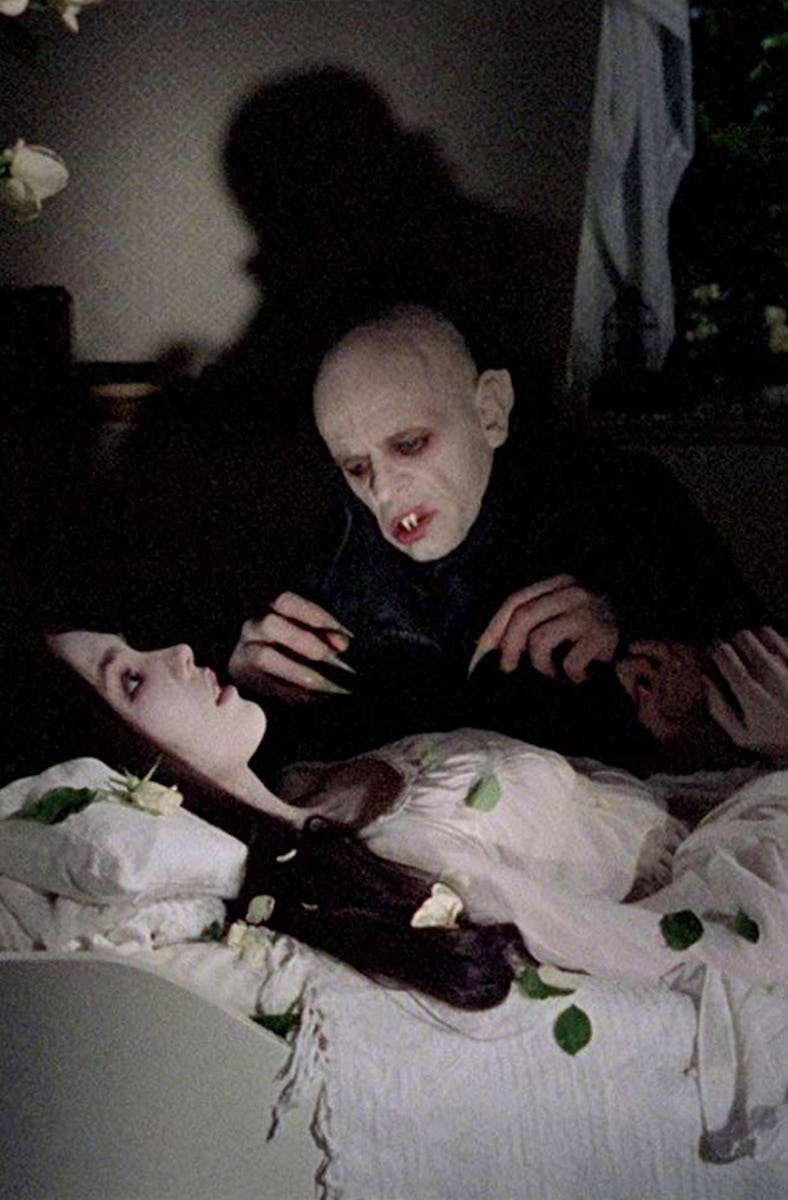Werner Herzog's Update to a Silent Classic Remains Deeply Chilling
You won’t fall for this vampire.

In 1979, three films based on Bram Stoker’s Dracula were released: John Badham’s Dracula, starring Frank Langella and adapted from the stage play; Stan Dragoti’s Love at First Bite, a comedy that drops the Count (George Hamilton) in modern-day New York City; and German director Werner Herzog’s Nosferatu the Vampyre, featuring Klaus Kinski in a remake of F.W. Murnau’s 1922 masterwork, Nosferatu: A Symphony of Horror.
Herzog’s film shot both a German and English cut, with the latter arriving in America 45 years ago this week. While initially the least successful of the three (the box office winner was the crude and now almost forgotten Love at First Bite), it has lingered in the consciousness of horror fans and cineastes thanks to Herzog’s reputation as an iconoclastic director, its audacious spin on already-legendary material, and the eerie power of its imagery and its star’s performance.
The original Nosferatu is a landmark of silent cinema and German Expressionism, not to mention a cornerstone of the horror genre. But because it wasn’t authorized by the widow of Bram Stoker (who nearly succeeded in having all prints of the film destroyed!), Murnau retained Dracula’s basic plot yet changed all the character names, in particular calling his vampire — played by the spectral Max Schreck — Count Orlok.
By the time Herzog got to work, Dracula had passed into the public domain, and the director was free to call the vampire by his actual name again. Herzog’s movie is more a reimagining of both Stoker’s novel (to which Herzog made liberal changes) and Murnau’s film than an outright remake; while the Murnau version is nightmarish and surreal, thanks to his Expressionist aesthetic and the dream-like quality intrinsic to silent films, Herzog’s effort is a combination of Gothic imagery and naturalism, with shooting in desolate, windswept areas of Slovakia adding a touch of otherworldliness.
Taking a contemporary approach to Schreck’s rodent-like, skeletal phantom, Herzog’s Dracula — brilliantly underplayed by the usually volatile Kinski — still has a rat-like quality to him and is completely bald, with sepulchral white skin and hollowed-out eyes. He seems to move either slowly or spasmodically, utterly still one moment and lightning-fast the next. He’s completely inhuman, yet in his own way, a “realistic” version of how a vampire might appear.
Kinski’s take on the vampire is unlikely to set many hearts aflutter.
He's also, like his 1922 predecessor, a welcome antidote to the hot bloodsuckers of franchises like Twilight and Interview with the Vampire (Frank Langella’s erotic interpretation on Broadway and in the 1979 Dracula might have been the kindling for that particular conflagration). Vampires are ultimately walking corpses; they may retain their memories and some semblance of human behavior, but they’re still the reanimated dead, with all that entails (Stoker’s literary Dracula was never accused of smelling good).
The Kinski version of Dracula makes that palpable, and even though he yearns for both love and mortality, those desires come from a place of darkness in what used to be his soul. This is no lovelorn Edward Cullen or angst-ridden Louis de Pointe du Lac, but a decrepit, unholy parasite who feeds off the life essence of others, even as he wishes for an end to his eternal loneliness.
The other aspect of Herzog’s Nosferatu, touched on in earlier Dracula films but a much stronger component of this narrative, is the decay and corruption the vampire brings with him wherever he goes. As in the book and other films, Dracula travels from Transylvania to, in this telling, Wismar, Germany, arriving on a ship carrying corpses, rats, and the plague. The last two soon spread.
Putrescence is soon everywhere. Coffins and debris pile up as the surviving townspeople remove their belongings from their homes and hurl them into the street before joining each other in macabre dances in the village square (an unsettling opening sequence in which the camera slowly pans over a long line of real mummified corpses, which Herzog shot in Mexico’s Mummies of Guanajuato museum, perhaps foreshadows Wismar’s doom).
Herzog’s take on the tale is Gothic and unsettling.
Only the pure-hearted Lucy Harker (Isabelle Adjani) knows what’s happening, but her plan to destroy Dracula by allowing him to feast on her blood until he’s caught by the sun’s rays in her bedroom goes awry; while Dracula does indeed perish, Lucy dies as well while her husband, Jonathan (Bruno Ganz), becomes a vampire himself and rides off at the end of the film, presumably to spread the legacy of Dracula to the next town and beyond.
That legacy, of course, is more destruction, more disease, and more corruption of the flesh. In the end, a vampire is nothing but an abomination, a perversion of nature that turns a human being into an undead leech. Nosferatu the Vampyre offers one of the best embodiments of that theme ever put on film, allowing Herzog’s homage to what he has called “the greatest German film” to stand proudly next to its ancestor, both now as immortal as the twisted creature of the night at their blackened hearts.